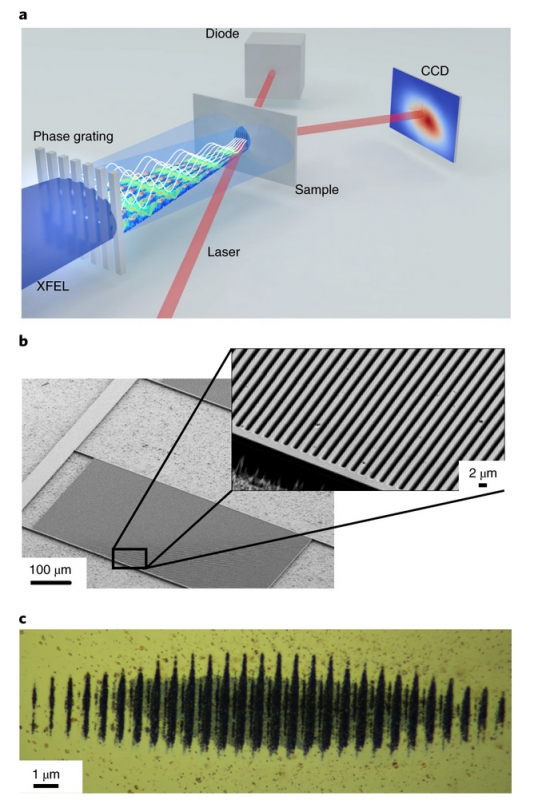Hard X-ray transient grating spectroscopy on bismuth germanate
April 23, 2021(Published in Nature Photonics)
Optical-domain transient grating (TG) spectroscopy is a versatile background-free four-wave-mixing technique that is used to probe vibrational, magnetic and electronic degrees of freedom in the time domain. The newly developed coherent X-ray free-electron laser sources allow its extension to the X-ray regime. X-rays offer multiple advantages for TG: their large penetration depth allows probing the bulk properties of materials, their element specificity can address core excited states, and their short wavelengths create excitation gratings with unprecedented momentum transfer and spatial resolution. Here, we demonstrate TG excitation in the hard X-ray range at 7.1 keV. In bismuth germanate (BGO), the non-resonant TG excitation generates coherent optical phonons detected as a function of time by diffraction of an optical probe pulse. This experiment at SwissFEL demonstrates the ability to probe bulk properties of materials and paves the way for ultrafast coherent four-wave-mixing techniques using X-ray probes and involving nanoscale TG spatial periods.

Figure: a, Schematic of the XTG set-up. The incoming XFEL pulse (in blue) is diffracted by a transmission phase grating. Interferences between the diffracted orders generate a Talbot carpet, that is, a region of self-images of the originating phase grating. The sample experiences a TG excitation with smaller spatial periodicity due to the convergence of the X-ray beam. A delayed optical pulse (in red) probes the dynamics stimulated by the XTG via transient diffraction, which are detected by an array detector (charge-coupled device, CCD). b, Scanning electron microscopy (SEM) image of a diamond phase grating. c, Permanent grating imprint on a gold surface placed at the sample position and illuminated with an intense XFEL pulse.
The relatively simple XTG approach used here can easily be implemented at any XFEL facility on solids or liquids, and to probe a broad range of materials such as magnetic systems, heterostructures, and excitonic systems such as light-harvesting complexes, to name a few. Indeed, the use of hard X-ray TG offers various advantages compared to optical or EUV TG. First, extremely small excitation grating periods (high TG wavevectors) are now achievable. In the present case, the main limitation is the wavelength of the optical probe, which puts a lower bound on the periodicity of the TG that can be probed. However, a hard X-ray probe can easily detect periods at the nanometric scales or even down to the ångström. Further limitations could arise from the phase grating pattern. Here, nanolithography techniques for the fabrication of diffractive hard X-ray lenses with periods of tens of nanometres have been developed. It may also become possible to use superlattice structures for the phase grating to move to even smaller periods, or to design other means of crossing the X-ray beams such that large angles θ can be achieved. The present phase grating period range can already provide access to bulk nanoscale heat, charge and spin transport regimes that are difficult to access through conventional methods.
The capability for rapidly changing the XTG wavevector by switching the phase grating patterns, as routinely done in optical TG experiments, will enable incisive transport measurements in the nanoscale range where macroscale diffusive kinetics may no longer apply. Elemental specificity will be extremely useful for electronic and spin measurements. With the ultrashort pulses of new X-ray sources (few femtoseconds or below), measurements of the coherent relaxation of core-hole states can become accessible, adding valuable information for core excited-state dynamics. The signal sensitivity could also be greatly improved by using self-heterodyne detection schemes that make use of the probe diffracted beam from the phase grating as a local oscillator. Finally, the Talbot approach can be readily extended to multi-colour FEL pulses for different excitation and probe wavelengths. This will facilitate the implementation of condensed phase analogues of theoretically proposed methods for the study of the delocalization of electronic excited states, electronic coherences and charge transfer processes, with ultrafast time resolution and atomic selectivity.
See also: EPFL News, EurekAlert,
Reference: Rouxel, J.R., Fainozzi, D., Mankowsky, R., Rösner, B., Seniutinas, G., Mincigrucci, R., Catalini, S., Foglia, L., Cucini, R., Döring, F., Kubec, A., Koch, F., Bencivenga, F., Haddad, A.A., Gessini, A., Maznev, A.A., Cirelli, C., Gerber, S., Pedrini, B., Mancini, G.F., Razzoli, E., Burian, M., Ueda, H., Pamfilidis, G., Ferrari, E., Deng, Y., Mozzanica, A., Johnson, P.J.M., Ozerov, D., Izzo, M.G., Bottari, C., Arrell, C., Divall, E.J., Zerdane, S., Sander, M., Knopp, G., Beaud, P., Lemke, H.T., Milne, C.J., David, C., Torre, R., Chergui, M., Nelson, K.A., Masciovecchio, C., Staub, U., Patthey, L., and Svetina, C. (2021). Hard X-ray transient grating spectroscopy on bismuth germanate. Nature Photon. (10.1038/s41566-021-00797-9).
<<
<<

 Ursula Keller wins “Swiss Nobel” Marcel Benoist Prize
Ursula Keller wins “Swiss Nobel” Marcel Benoist Prize Farewell: the NCCR MUST ended
Farewell: the NCCR MUST ended  MUST2022 Conference
MUST2022 Conference New scientific highlights
New scientific highlights FELs of Europe prize for Jeremy Rouxel
FELs of Europe prize for Jeremy Rouxel Ruth Signorell wins Doron prize
Ruth Signorell wins Doron prize New FAST-Fellow Uwe Thumm at ETH
New FAST-Fellow Uwe Thumm at ETH International Day of Women and Girls in Science
International Day of Women and Girls in Science New scientific highlight
New scientific highlight EU XFEL Young Scientist Award for Camila Bacellar,
EU XFEL Young Scientist Award for Camila Bacellar, Prizes for Giulia Mancini and Rebeca Gomez Castillo
Prizes for Giulia Mancini and Rebeca Gomez Castillo Nobel Prize in Chemistry awarded to RESOLV Member Benjamin List
Nobel Prize in Chemistry awarded to RESOLV Member Benjamin List Hans Jakob Wörner invited to give the „New Horizons Solvay Lectures”
Hans Jakob Wörner invited to give the „New Horizons Solvay Lectures”  Unusual keynote talk at an international scientific conference
Unusual keynote talk at an international scientific conference NCCR MUST at Scientifica 2021
NCCR MUST at Scientifica 2021